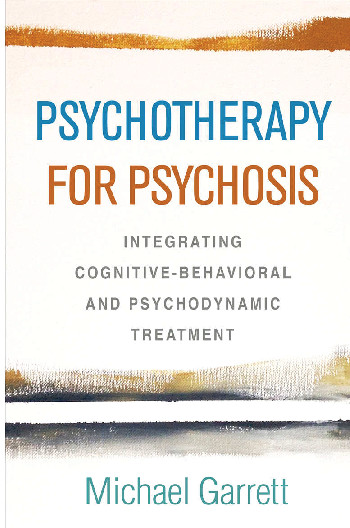By Michael Garrett, M.D.; New York, Guilford Press, 2019, 354 pages
Dr. Michael Garrett, a psychiatrist at SUNY Downstate Medical Center in New York, focuses on “ambitious” psychotherapy for those with psychotic disorders. In his book, Psychotherapy for Psychosis: Integrating Cognitive-Behavioral and Psychodynamic Treatment, the author first describes selected theories of psychosis from the field as well as his personal conceptualization of psychosis, which is based in psychodynamic theory. He also pulls from cognitive-behavioral and biological perspectives. Within his conceptualization, Garrett frames the experience of psychosis as “an autobiographical play staged in the real world,” a metaphor he refers to throughout the book. Next, the author discusses more concrete therapy techniques. He argues that a cognitive-behavioral therapy for psychosis (CBTp) phase should come first in treatment, to help patients understand the “literal falsity” of their beliefs and perceptions, followed by a psychodynamic phase (the majority of treatment, one might surmise from the text, which he suggests should continue indefinitely) that aims to help patients understand the “figurative truth” manifested in psychotic symptoms. In the final section, the author discusses public mental health services and their general de-emphasis of psychotherapy as an essential component of treatment. He concludes by suggesting how the public mental health system might change to facilitate provision of therapeutic services to those with psychosis.
The greatest strength of Garrett’s work is that it is aggressively recovery oriented, a welcome approach in psychotherapy for those with psychosis. His assertion that psychotherapy should be “ambitious” will likely ring true to providers of psychotherapy to persons in this complex group. A one-size-fits-all approach poorly serves those with psychosis, and those who are severely or chronically ill may need more time in therapy to achieve its full benefit. Another strength of this work is that throughout the book, Garrett interweaves examples of his own case work and provides illustrations of times when he has used the described techniques with success. These examples make the book very engaging and help to paint a clearer picture of Garrett’s approach.
Although there is much to be learned from Garrett’s work, it should be noted that his approach seems to be, at its heart, psychodynamic. This is in contrast with what one might expect from the book’s title and synopsis, which both place CBTp first in their description of Garrett’s approach and suggest greater integration between these distinct techniques. Instead, Garrett’s book positions CBTp as an entrée into more extensive psychodynamic work. Also of note, Garrett’s psychodynamic background is evident throughout the book, but he does not provide enough context or information to enable therapists without comparable psychodynamic training to implement his recommendations. Garrett clearly states that the book is not intended to be a comprehensive primer on the techniques described. However, the complexity of the psychodynamic elements that Garrett suggests and his recommendation to provide full psychodynamic psychotherapy once the CBTp phase is complete limit Garrett’s audience to those who are already competent in psychodynamic approaches. These factors may restrict the reach of his book because many psychosis-oriented practitioners focus on cognitive-behavioral approaches, as Garrett acknowledges in his comments on the predominant therapeutic approaches in the field. This trend is justifiable considering the wealth of research evidence supporting CBTp (
1) compared with a notable lack of evidence supporting the efficacy or effectiveness of psychodynamic psychotherapy for those with psychotic disorders (
2). Indeed, a discussion of the research evidence for or against psychodynamic psychotherapy for psychosis is conspicuously absent from Garrett’s book—a notable oversight considering the mixed history of psychodynamic work with persons with psychosis.
This book is a good read for practitioners with a specialty practice in psychosis, and it could be of great value for psychodynamic practitioners who work with persons with psychosis and want to broaden their approach. Garrett’s work could also be relevant for others with an interest in learning about novel approaches to psychotherapy for psychosis. Garrett’s determinedly recovery-oriented approach is much appreciated in a field where recovery-oriented services are not assured, and it is clear that he has helped many people with psychosis over his career.


